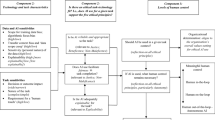Abstract
This paper describes a two-stage approach to nurse scheduling that considers both nurse preferences and hospital constraints. In the auction stage, nurses bid for their preferred working shifts and rest days using “points”. An optimization model awards shifts to the highest bidders insofar as possible while maintaining hospital requirements. In the schedule completion stage, an optimization model allocates the unfilled shifts to nurses who have not yet met their minimum required hours. The approach is demonstrated via a case study in the emergency department at York Hospital. A schedule with a high percentage of awarded bids was generated in a few minutes of computer time. Further experimentation suggests that the approach works well under a variety of conditions.



Similar content being viewed by others
References
Bureau of Health Professions (2004). What is Behind HRSA’s Projected Supply, Demand, and Shortage of Registered Nurses. Available at http://bhpr.hrsa.gov/healthworkforce/reports/behindrnprojections/index.htm. Accessed June 2008
Sagie A, Krausz M (2003) What aspects of the job have most effect on nurses? Hum Resour Manag J 13:46–62 doi:10.1111/j.1748-8583.2003.tb00083.x
Kellogg D, Walczak S (2007) Nurse scheduling: from academia to implementation or not? Interfaces 37(4):355–369 doi:10.1287/inte.1070.0291
Koeppel D (2004) Nurses bid with their pay in auctions for extra work. The New York Times, June 6
Miller A (2004) Nursing shifts up for bid: Riverdale hospital to use web to match RNs and extra work. The Atlanta Journal—Constitution, August 13, E1
Sidime A (2005) Bidding for work. Knight Ridder Tribune Business News, February 28
Cheang H, Lim A, Rodrigues B (2003) Nurse rostering problems—a bibliographic survey. Eur J Oper Res 151:447–460 doi:10.1016/S0377-2217(03)00021-3
Burke E, De Causmaecker P, Berghe G, Van Landeghem H (2004) The state of the art of nurse rostering. J Sched 7:441–499 doi:10.1023/B:JOSH.0000046076.75950.0b
Burns R (1978) Manpower scheduling with variable demands and alternate weekends off. Infor 16(2):101–111
Bard J, Purnomo H (2005) Preference scheduling for nurses using column generation. Eur J Oper Res 164:510–534 doi:10.1016/j.ejor.2003.06.046
Jaumard B, Semet F, Vover T (1998) A generalized linear programming model for nurse scheduling. Eur J Oper Res 107:1–18 doi:10.1016/S0377-2217(97)00330-5
Abernathy W, Baloff N, Hershey J, Wandel S (1973) A three-stage manpower planning and scheduling model—a service-sector example. Oper Res 21(3):693–711
Warner D (1976) Scheduling nursing personnel according to nursing preference: a mathematical programming approach. Oper Res 24(5):842–856
Arthur J, Ravindran A (1981) A multiple objective nurse scheduling model. IIE Trans 13:55–60 doi:10.1080/05695558108974536
Ozkarahan I, Bailey J (1988) Goal programming model subsystem of a flexible nurse scheduling support subsystem. IIE Trans 20(3):306–316 doi:10.1080/07408178808966185
Ozkarahan I (1989) A flexible nurse scheduling support system. Comput Methods Programs Biomed 30(2–3):145–153 doi:10.1016/0169-2607(89)90066-7
Warner D, Prawda J (1972) A mathematical programming model for scheduling personnel in a hospital. Manage Sci 19(4):411–422
Ferland J, Berrada I, Nabli I, Ahoid B, Michelon P, Gascon V, Gagne E (2001) Generalized assignment type goal programming problem: application to nurse scheduling. J Heuristics 7:391–413 doi:10.1023/A:1011392328632
Dowsland K, Thompson J (2000) Solving a nurse scheduling problem with knapsacks, networks and tabu search. J Oper Res Soc 51:825–833
Azaiez M, Al Sharif S (2005) A 0–1 goal programming model for nurse scheduling. Comput Oper Res 32:491–507 doi:10.1016/S0305-0548(03)00249-1
Berrada I, Ferland J, Michelon P (1996) A multi-objective approach to nurse scheduling with both hard and soft constraints. Socio-econ Plann Sci 30:183–193 doi:10.1016/0038-0121(96)00010-9
Miller H, Rath G, Pierskalla W (1976) Nurse scheduling using mathematical programming. Oper Res 24:857–870
Griesmer H (1993) Self-scheduling turned us into a winning team. RN 56(12):21–23
Miller M (1984) Implementing self-scheduling. J Nurs Adm 14:33–36 doi:10.1097/00005110-198403000-00011
Ringl K, Dotson L (1989) Self-scheduling for professional nurses. Nurs Manage 20:42–44 doi:10.1097/00006247-198902000-00013
Silvestro R, Silvestro C (2000) An evaluation of nurse rostering practices in the National Health Service. J Adv Nurs 32:525–535 doi:10.1046/j.1365-2648.2000.01512.x
Lawrence S (2004) System lets nurses bid for shifts. Available at http://www.eweek.com/article2/0,1895,1666200,00.asp. Accessed on September 2006
Klemperer P (1999) Auction theory: a guide to the literature. J Econ Surv 13:227–286 doi:10.1111/1467-6419.00083
Warner M, Keller B, Martel S (1991) Automated nurse scheduling. J Soc Health Syst 2(2):66–80
The Free Online Medical Dictionary. Available at http://medical-dictionary.thefreedictionary.com/p.r.n
Sönmez T, Ünver U (2003) Course Bidding at Business Schools. Available at http://129.3.20.41/eps/game/papers/0306/0306001.pdf. Accessed on February 2007
Author information
Authors and Affiliations
Corresponding author
Rights and permissions
About this article
Cite this article
L. De Grano, M., Medeiros, D.J. & Eitel, D. Accommodating individual preferences in nurse scheduling via auctions and optimization. Health Care Manag Sci 12, 228–242 (2009). https://doi.org/10.1007/s10729-008-9087-2
Received:
Accepted:
Published:
Issue Date:
DOI: https://doi.org/10.1007/s10729-008-9087-2




